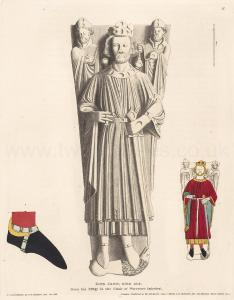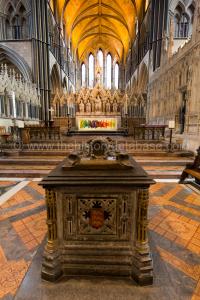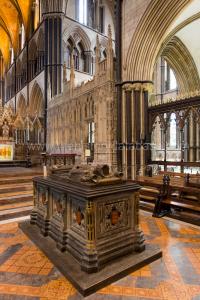Effigy of King John
Effigy of King John is in Monumental Effigies of Great Britain.
THIS remarkable personage [King John], the events of whose "troublesome reign" are so conspicuous in English History—and from whose disputes with his Barons we derive the foundation deed of our liberties, Magna Charta, was born at Oxford in 1166. He was the youngest son of Henry the Second, by his wife Eleanor of Guienne. His father jestingly called him Sans Terre or Lackland, as if, being born last, he had nothing left to give him. He, however, created him Earl of Mortagne in Flanders (latinized in the public acts of the time "Comes Moritonie"), of Cornwall, and Gloucester, made him titular King of Ireland, which grant was confirmed by the Pope, and endowed him with divers other honours and possessions. His first wife [Note. King John was betrothed, not married, to Alice] was Alice, daughter of Humbert second Earl of Maurienne, now called Savoy; this marriage was contracted by the parties in their childhood, A. D. 1173, and John, by the death of Alice, lost his claim, in her right, to her fathers possessions. His second wife was Isabella, daughter of Robert Earl of Gloucester, natural son of King Henry the First [Note. Isabella was the daughter of William Fitzrobert 2nd Earl Gloucester who was the son of Robert Earl of Gloucester]; but falling desperately in love with Isabella, daughter of Aymer Earl of Angoulesme, he procured a divorce from Isabella of Gloucester, under the plea of having contracted a marriage with her within the third degree of consanguinity, and in 1200 married Isabella de Angoulesme. King John, in the midst of public commotions (to which his misgovernment had largely contributed) and adverse fortune, was cut off by death at Newark, on the 19th October 1216, in the eighteenth year of his reign. His death is assigned by Matthew Paris, a writer who lived in his own time, to natural causes, induced by grief for the disaster which had occurred to his army in crossing the Well Stream or Lincoln Washes, in his march to oppose Lewis son of the King of France, who, backed by the discontented Barons, pretended to his Kingdom. Having rested at Swinesheada Abbey, in his way to Newark, for a night, a story gained ground that the final catastrophe of his life was accelerated by poison administered to him by a monk. There is no conclusive circumstantial evidence to support this tale. Speed, the historian, asserts, that it was believed as a fact by his son King Henrv the Third, and refers, as his authority, to the reply made by that King to the hold address of the Prior of the Hospitallers at Clerkenwell as related by Matthew Paris. The expressions of that writer appear, however, too vague to support such an inferenceb. The poisoning of John must, therefore, remain in the list of insoluble historic doubts. His own will, preserved in the archives of the Dean and Chapter of Worcester, merely says, that, being seized with a severe distemper he has no time for making particular arrangements. He appoints certain nobles and dignified ecclesiastics his executors, directs them, in general terms, by donations to religious houses, and alms to the poor, to make, for the good of his soul, reparation for injuries done to God and holy Church. He annexes the usual anathema against any who shall infringe their disposition of his property. He directs his body to he buried in the Church of St. Mary and St. Wulstan, the Cathedral at Worcester [Map]. John, in his last moments, commended his soul to God and St. Wulstan, his body, royally attired, was conveyed to Worcester, over his head was placed a monk's cowl, as a sort of cover for all his sins and a passport to Heaven. He was interred between St. Oswald and St. Wulstan, whose graves are in the Chapel of the Virgin at the eastern extremity of the Cathedral [Map]. Thence, in all probability, they underwent translation to their present situation before the high altar in the Choir.

Note a. Not Swinestead for Swineshead is an error which has crept into some received authorities owing to the great similarity in name of these two different piaces in Lincolnshire. See Gent. Mag. June 1855, p.491.
Note b. These are given as the King's words, "O quid sibi vuit istud, vos Anglici, vultis ne me sicut quondam patrem meum a regno precipitate atque necare prsecipitatum [Oh, what does that mean, you Englishmen, do you wish that you would not rush me from the kingdom and kill me as my father once was]?" Matt. Paris, Hist. Angi. edit. Watts, p. 854.
The effigy of John, carved in grey marble, which forms the superstructure of his present tomb, was originally the lid of the stone coffin that contained his remains, and in its first position must have been placed on a level with the floor of the building within which he was interred. His head is adorned with a crown of state and supported by two Bishops, undoubtedly intended for Oswald and Wulstan, between whose remains he, as before-mentioned, actually reposed. He is represented as wearing a dalmatic of crimson lined with green, the neck and cuffs edged with a gold and jewelled border; his tunic is yellow, or cloth of gold; he is girt with a belt; on his hands are jewelled gloves, a ring on the middle finger of his right hand, which supports a sceptre, while his left grasps a sword. He wears red hose, golden spurs, his feet have on them black shoes, and rest upon a lion [Note. Which is biting the scabbard]. The greater part of these details will be recognized as the ensigns of royalty.

Valentine Green, F.S.A. the historian of Worcester, published a pamphlet, giving a very interesting account of the opening of the tomb of King John on the 17th of July 1797. Two walls of were found to form the supporters of the effigy of the monarch. The coffin containing his remains, of which it had originally formed the top, was covered with two strong elm planks, the intervening spaces between the sides of the tomb and the effigy, being filled up with mortar and brick rubbish. These circumstances, and the state of the King's mortal relics, shewed that they had been at some previous time disturbed, and seem to favour the conjecture of their having been translated from the Lady Chapel in the Cathedral into the Choir, most probably about the time of Henry the Seventh, as the altar tomb, on which the coffin lid lies, resembles the monument of Prince Arthur in the same Church, and brick was much employed in architecture about that period. The skull was found turned completely round, and presented what anatomists term the foramen magnum, or aperture through which the spinal marrow passes. The upper jaw lay near the right elbow. The agreement of the dress on the body with that of the effigy on the tomb was very remarkable, and shews, as in the instance of Henry the Second's figure, that these effigies very faithfully represented the defunct as he lay in state. John had, however, no crown on his head or gloves on his hands; in the place of the former was found the celebrated monk's cowl, confirming the minute accuracy of the Chronicles. This sacred envelope fitted the head very closely, and had been buckled under the chin by straps, parts of which still remained. The body had been covered with a crimson robe of damask of strong texture, reaching from the neck to the feet: see the effigy. Part of the embroidery was still perfect near the left knee. His left arm was bent towards his breast, and the hand had grasped a sword in the same manner as on the tomb. The cuff of this arm still remained lying on the breast. The sword was much decomposed and its parts found at intervals down the left side, the scabbard was much more perfect. The covering of the legs (the precise nature of which was not ascertained) was tied round the ancles. These were probably the red hose seen in the effigy. Thus lay royal John, as the immortal dramatizer of his reign has said, — but now a king—now thus — A clod and module of confounded royalty!

Matthew Paris has given the following as his epitaph, which, like many others of the same cast on our early Kings, had perhaps a place in the Chronicle, but not on the tomb:
Hoc in sarcophago sepelitur Regis imago, [In this sarcophagus is buried the image of the King]
Qui moriens multum sedavit in orbetumultum, [By dying he calmed much of the tumult]
Et cui connexa dum vixit probra manebant, [And to whom they were attached as long as they lived]
Hunc mala post mortem timor est ne fata sequantur, [It is the fear that the fates will follow this evil after death]
Qui legis haec metuens dum cernis te moriturum, [He who reads this fearing to see you will die]
Discite quid rerum pariat tibi meta dierum.a [Learn what your goals are for the day]
Note a. Matt. Paris, Hist. Ang. edit. Watts, p. 288.
Details. Plate I. 1. The figure of the King with the original painting restored. 2. The shoe, spur leather, &c. Plate II. The Crown.
Archaeologia Volume 21 Section XXXII. The care and attention with which the sculptor carved the attendants upon this Effigy, induces me to believe them to be the figures of her children; for they are much larger than those upon other monuments of its own time, before or since. Those of other monumental effigies are represented supporting the crest, as in Aymer de Valence’s; burning incense, as in John’s; and generally, as in these, they are represented with wings, as angels; but those in the Effigy at Stevenage bear evident marks of uncommon attention being paid to distinguish them from others. And I am induced to believe also, that the one on the left with the cowl, represents John de Stevenage, a cellarer of St. Alban’s Monastery, from the 27th to the 31st of Edward the First, 1298 to 1302, a descendant of the original founder of the Abbey of Stevenage. The Village of Stevenage derived its name from a monastery which formerly stood near or on the site of the present church, about half a mile from the road. Chauncy says, the Abbot of Stevenage held it of the gift of Edward the Confessor, and claimed very large liberties by the grants of the said King, and the grants of William the Conqueror, Henry the First, and Richard the First, which upon a quo warranto therein allowed,a and the Abbot thereof did continually enjoy it until the dissolution of the great Monasteries.
After 19 Oct 1216 King John "Lackland" of England (age 49) was buried in the Lady Chapel of Worcester Cathedral [Map]. Originally his effigy would have covered his coffin at floor level. Sometime around 1500 his tomb was moved to the Choir in front of the High Altar - the Chest Tomb similar to that of Prince Arthur's nearby. The Purbeck Marble effigy is the earliest of a King in England. Unusually carved to be life-like. His head supported by St Oswald and St Wulfstan, the two patron saints of Worcester. The base constructed in the 16th Century. The tomb was opened again on Monday 17 Jul 1797 at the instigation of Valentine Green (1739-1813). Inside the tomb chest, a stone coffin was discovered, containing the royal remains - see Monumental Effigies.

